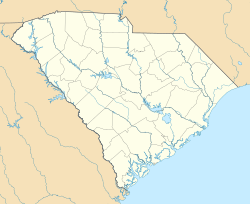Bradley's Covered Bridge facts for kids
|
Bradley's Covered Bridge
|
|
|
Formerly listed on the U.S. National Register of Historic Places
|
|
| Nearest city | Troy, South Carolina |
|---|---|
| Area | less than one acre |
| Built | 1892 |
| Architectural style | Howe truss |
| NRHP reference No. | 77001512 |
Quick facts for kids Significant dates |
|
| Added to NRHP | 1977 |
| Removed from NRHP | August 31, 1979 |
Bradley's Covered Bridge, also known as the Long Cane Covered Bridge, was a special covered bridge in South Carolina. It was located near the town of Troy, South Carolina. This bridge was once one of only three covered bridges in the entire state.
Contents
The Story of the Bridge
The Long Cane Covered Bridge was built in 1892. It replaced an older bridge that had been washed away by a flood in January of that year. Y.P. Reagan was the person who built this new bridge.
It was first called "Bradley's Bridge." This was because it was very close to a mill owned by John Bradley. The bridge became an important part of the local area.
How the Bridge Was Built
The bridge used a special building style called the Howe truss. This design was very popular at the time. It was a clever way to build bridges. The Howe truss used strong wooden beams. It also added iron rods to make the bridge even stronger.
This design was a big step forward in bridge building. It helped engineers learn how to build bridges with iron and steel. The Howe truss was a link between old wooden bridges and newer metal ones.
Bridge Dimensions and Features
Bradley's Covered Bridge was quite large. It stood about 30 feet high. The bridge stretched 163 feet across Long Cane Creek. It rested on two strong stone supports called abutments. There were also four piers in the creek bed to help hold it up.
The bridge had thirteen boxed X-panel trusses. These were like strong, crisscross frames. Iron turnbuckles helped keep them stable. The sides of the bridge were covered with wooden boards. These boards were cut unevenly and were not painted. The entrances to the bridge were also covered with unpainted wooden planks. A tin roof protected the bridge from the weather.
A Place in History
In 1977, the Long Cane Covered Bridge was added to the National Register of Historic Places. This list includes important historical places in the United States. Being on this list meant the bridge was recognized for its special history and design.
Sadly, the bridge was later destroyed by fire. It was removed from the National Register on August 31, 1979. Even though it is gone, its story remains a part of South Carolina's history.



